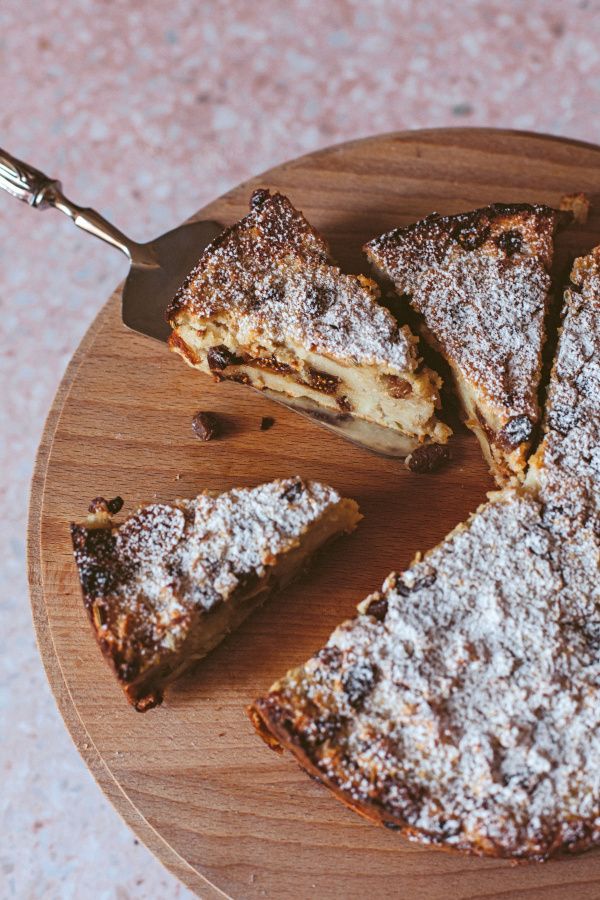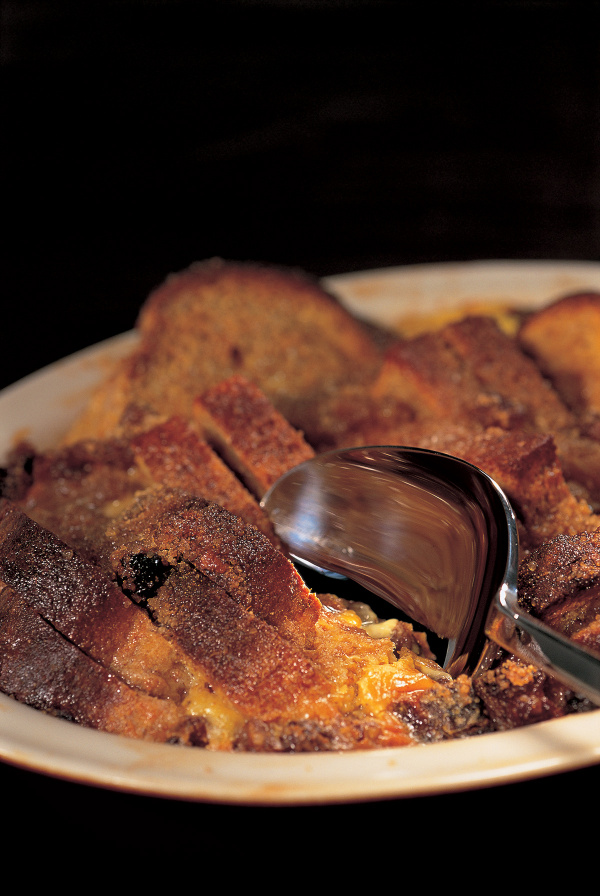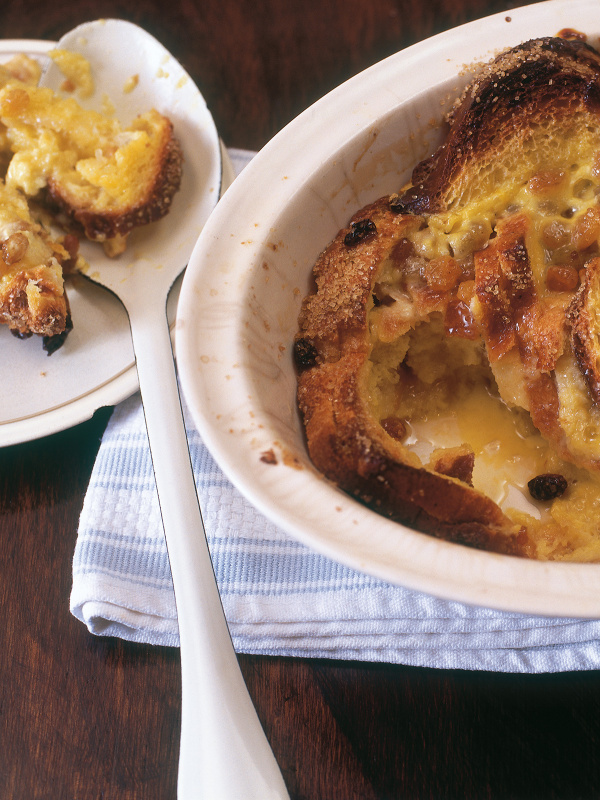Pinza di Pane
by Emiko Davies, featured in Cinnamon and Salt Published by Hardie GrantIntroduction
This is an ancient recipe — possibly the most ancient of the Venetian dessert repertoire — that has a special role for the Epiphany, on 6th January, and the start of Venice’s Carnival season. As old traditions went, young singles on this day had to eat a slice of pinza in seven different houses to guarantee getting married within the year. As it is a homely dish, and one that makes good use of leftovers or whatever you have on hand, you can find pinza made with all kinds of grains as the base — polenta is very common, but also buckwheat, regular flour or stale bread. I have a soft spot for bread puddings, and this is my favourite version, closely followed by the polenta one. Like the Pan del doge di Zaira, you’ll find it studded with dried fruit (usually figs and sultanas), which sometimes may have been the only sweet contribution in this pudding, and nuts of all kinds, some sort of liquid, be it milk with a splash of white wine, grappa or Alkermes, but also an array of spices such as wild fennel seeds, cinnamon or nutmeg. It’s quite a soft pudding, not too dense, no matter what it is made with, perfumed with citrus and fennel, full of dried figs and sultanas, and it is to be washed down with a glass of sweet wine such as Marsala.
This is an ancient recipe — possibly the most ancient of the Venetian dessert repertoire — that has a special role for the Epiphany, on 6th January, and the start of Venice’s Carnival season. As old traditions went, young singles on this day had to eat a slice of pinza in seven different houses to guarantee getting married within the year. As it is a homely dish, and one that makes good use of leftovers or whatever you have on hand, you can find pinza made with all kinds of grains as the base — polenta is very common, but also buckwheat, regular flour or stale bread. I have a soft spot for bread puddings, and this is my favourite version, closely followed by the polenta one. Like the Pan del doge di Zaira, you’ll find it studded with dried fruit (usually figs and sultanas), which sometimes may have been the only sweet contribution in this pudding, and nuts of all kinds, some sort of liquid, be it milk with a splash of white wine, grappa or Alkermes, but also an array of spices such as wild fennel seeds, cinnamon or nutmeg. It’s quite a soft pudding, not too dense, no matter what it is made with, perfumed with citrus and fennel, full of dried figs and sultanas, and it is to be washed down with a glass of sweet wine such as Marsala.

Share or save this
Ingredients
Serves: 10
- 250 - 300 grams stale bread (about half a large country-style loaf)
- 500 - 750 millilitres warm full-cream (whole) milk
- 150 grams sultanas
- 60 millilitres grappa, or rum or white wine
- 2 eggs
- 80 grams sugar
- 60 grams butter (melted) plus extra for greasing
- 1 teaspoon fennel seeds (bashed slightly in a mortar and pestle)
- zest of 1 orange
- zest of 1 lemon
- 150 grams roughly chopped dried figs
- icing sugar for dusting (optional)
- 9 - 10½ ounces stale bread (about half a large country-style loaf)
- 2 - 3 cups warm full-cream (whole) milk
- 1 cup golden raisins
- ¼ cup grappa, or rum or white wine
- 2 eggs
- ⅓ cup sugar
- ¼ cup butter (melted) plus extra for greasing
- 1 teaspoon fennel seeds (bashed slightly in a mortar and pestle)
- zest of 1 orange
- zest of 1 lemon
- 1 cup roughly chopped dried figs
- confectioners' sugar for dusting (optional)
Method
Pinza di Pane is a guest recipe by Emiko Davies so we are not able to answer questions regarding this recipe
- Tear or cut up the bread (whether you leave crusts on or off is up to you, but you should end up with a total of about 250–300 g/9–10½ oz) and let it soak in 500 ml (17 fl oz/2 cups) warm milk until you can easily crumble or mash the bread — add more milk if needed, or leave overnight (see Additional Info below).
- Preheat the oven to 180°C (350°F). While the bread is soaking, place the sultanas in a bowl to steep in the grappa. If not using alcohol, simply use water.
- Stir the bread with its leftover milk with a wooden spoon (it should break up easily) — you could also use a food processor — until you have a dense, crumbly sort of batter. In a separate bowl, whisk the eggs and sugar together with the butter. Add the fennel seeds and zests and then, with a spoon or spatula, fold in the bread mixture until it is creamy and well combined. Add the sultanas (with their grappa) and the figs and combine.
- Grease a baking tin with butter and line with baking paper or dust with flour (this is such a homely recipe, use whatever tin you have, a springform round cake tin around 22–25 cm/8¾–10 in wide, or a 23 cm/9 in square tin, like a brownie tin, would work perfectly. I’ve even done this in an oval ceramic dish).
- Bake for 35–45 minutes, or until the pudding is golden brown and set. It should feel firm on top. Serve warm or cold, dusted with icing sugar before serving, if you wish. Keep any leftovers in the fridge for up to 3 days.
- Tear or cut up the bread (whether you leave crusts on or off is up to you, but you should end up with a total of about 250–300 g/9–10½ oz) and let it soak in 500 ml (17 fl oz/2 cups) warm milk until you can easily crumble or mash the bread — add more milk if needed, or leave overnight (see Additional Info below).
- Preheat the oven to 180°C (350°F). While the bread is soaking, place the golden raisins in a bowl to steep in the grappa. If not using alcohol, simply use water.
- Stir the bread with its leftover milk with a wooden spoon (it should break up easily) — you could also use a food processor — until you have a dense, crumbly sort of batter. In a separate bowl, whisk the eggs and sugar together with the butter. Add the fennel seeds and zests and then, with a spoon or spatula, fold in the bread mixture until it is creamy and well combined. Add the golden raisins (with their grappa) and the figs and combine.
- Grease a baking tin with butter and line with baking paper or dust with flour (this is such a homely recipe, use whatever tin you have, a springform round cake tin around 22–25 cm/8¾–10 in wide, or a 23 cm/9 in square tin, like a brownie tin, would work perfectly. I’ve even done this in an oval ceramic dish).
- Bake for 35–45 minutes, or until the pudding is golden brown and set. It should feel firm on top. Serve warm or cold, dusted with confectioners' sugar before serving, if you wish. Keep any leftovers in the fridge for up to 3 days.
Additional Information
NOTE
The quantity of milk you will need will depend on the texture of your bread and how stale it is. Start with 500 ml (17 fl oz/2 cups) and if it is quite stale, leave it to soak, even overnight, and you may need to add 250 ml (8½ fl oz/1 cup) more milk. It should be easy to crumble or mash.
NOTE
The quantity of milk you will need will depend on the texture of your bread and how stale it is. Start with 500 ml (17 fl oz/2 cups) and if it is quite stale, leave it to soak, even overnight, and you may need to add 250 ml (8½ fl oz/1 cup) more milk. It should be easy to crumble or mash.






Tell us what you think
Thank you {% member.data['first-name'] %}.
Explore more recipesYour comment has been submitted.